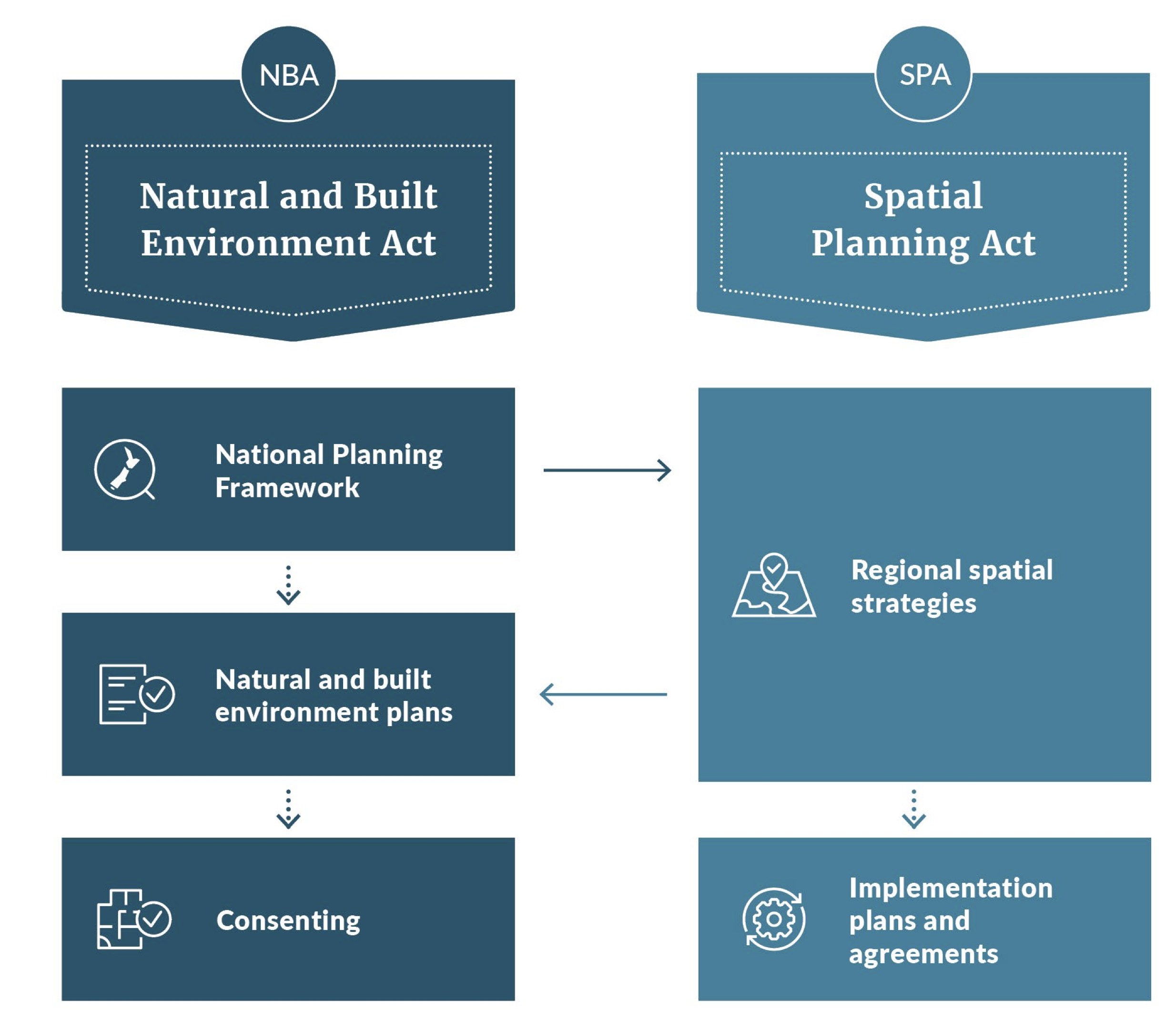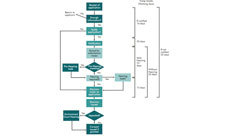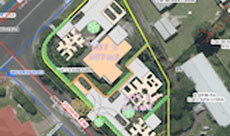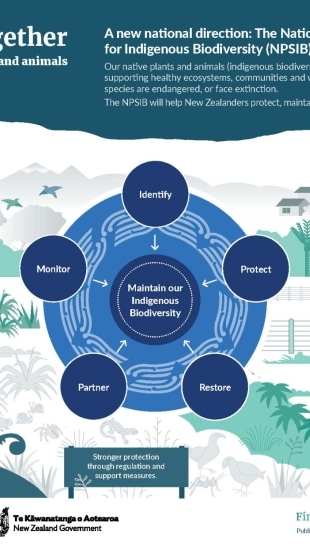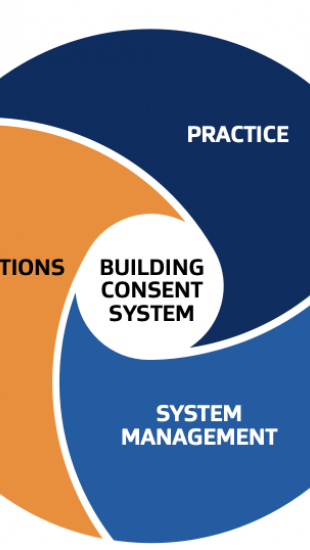The Natural and Built Environment Act and the Spatial Planning Act

New resource management system is now law
The Natural and Built Environment Act and the Spatial Planning Act were passed into law on 23 August 2023.
The new legislation creates a resource management (RM) system that aims to deliver better outcomes for the environment, people and the economy. The new system will protect and restore the environment while enabling development within environmental limits.
This new legislation is intended to be introduced over time, and the Resource Management Act 1991 (RMA) remains in force until each region transitions to the new system or there is a change of direction.
The Ministry is currently developing national direction under both the RMA and the NBA. National direction provides direction and guidance on matters of national significance such as how freshwater is managed. Several consultations for new or amended national direction are currently underway and are open for feedback.
The Spatial Planning Board, an interdepartmental executive board established under the Public Services Act 2020, oversees the implementation of the Spatial Planning Act 2023, while also having monitoring, evaluating and reporting responsibilities for the Act.
Each region will switch to the new system when its natural and built environment plan (NBE plan) comes into effect. Many instruments made under the Resource Management Act 1991 (RMA) will remain in place until then, including councils’ policy statements, regional and district plans.
The NBA contains a set of decision-making, procedural and information principles. People who exercise powers and perform functions and duties under the NBA must comply with the obligations that apply to them. The principles are in sections 8 to 10 of the NBA.
Managing the adverse effects of using and developing the environment remains an important part of the NBA. However, unlike the RMA’s focus on avoiding, remedying and mitigating effects in the first instance, the NBA specifies that adverse effects are managed in a way that achieves, and doesn’t undermine, outcomes.
The NBA provides for a fast-track consenting process for certain infrastructure and housing activities. The fast-track process is available for both resource consents and for notices of requirement to designate land, from 24 August 2023.
Part 11 of the NBA contains the compliance and enforcement provisions from the Resource Management Act 1991 (RMA), and new or expanded tools and powers to support increased deterrence, more flexible intervention, and the ability for councils to recover costs.
The NBA addresses the management of contaminated land differently to the Resource Management Act 1991 (RMA). The emphasis in the NBA has shifted to the polluter-pays principle, meaning that those who cause or allow contamination to occur bear the costs of managing the pollution. There is also a clear responsibility for regulatory agencies and landowners to prevent or remedy harm to human health and the environment from contamination and to minimise further harm.
The NBA contains provisions relating to requiring authorities that will take effect from November 2023.
The NPF sets out methods, indicators and other requirements that apply to the monitoring of environmental limits and targets. This will support consistency for monitoring across the country. It will also help provide long-term and comparable national trends on environmental conditions, as well as an evidence base for regional and national environmental reporting and decision-making.
Snapshot of key changes in the new resource management system
- Moves to an outcomes-based system, rather than just managing adverse effects
- Provides comprehensive and integrated national direction
- Gives effect to the principles of te Tiriti and provides a more strategic role for Māori in regional and national strategy and planning
- Establishes a regional collaborative approach to planning and reduces the number of resource management plans
- Provides a more strategic and coordinated approach to long-term regional planning by central government, local government and Māori
- Requires more planning up front to identify what activities are permitted, thus reducing the need to apply for resource consents
- Moves to efficient and equitable resource allocations
- Improves monitoring, reporting and oversight.
The RM journey
Over the past several years, the reform of the RM system has been carried out in phases. This has included amendments to the Resource Management Act (RMA), new rules to protect and restore freshwater, and legislation to enable the supply of housing.
A comprehensive review of the entire RM system by an expert panel, led by former Court of Appeals judge Hon Tony Randerson KC, provided the basis for the policy that underpins the new Acts.
In 2020, the Government committed to repeal the RMA and enact three new Acts in its place. Two of these became law on 23 August.
- Natural and Built Environment Act (NBA)sets out how the environment will be protected and used. It covers land use, along with environmental protection, water takes, discharges and use of the coastal marine areas.
- Spatial Planning Act 2023(SPA)fills a critical gap in the current resource management system and mandates that each region will create a long-term spatial strategy.
- The third proposed piece of legislation,Climate Change Adaptation Bill (CCAB), would address community-led retreat and climate adaptation funding and financing. A select committee inquiry into climate adaptation has been opened, which supports the development of the CCAB.
Key aspects of the new system
Decision-making in the new RM system focuses on achieving the outcomes specified in the new Acts, rather than just managing adverse effects on the environment.
New tools will help provide direction and ensure consistency, particularly the National Planning Framework (NPF) and regional spatial strategies (RSS) that carry statutory weight. These documents will inform the comprehensive natural and built environment plans (NBE plans) which will reduce reliance on individual consenting decisions.
There will be a shift towards more collaborative and integrated regional planning. The number of local government RM plans will reduce from more than 100, down to 15 RSS and 16 NBE plans. The NBA includes measures to strengthen local voice and provide for the needs of the communities within each region.
The new system now gives effect to the principles of te Tiriti o Waitangi and provides greater opportunities for Māori participation. A new National Māori Entity will be established, which will monitor te Tiriti performance. The entity will not be representative of hapū, iwi or Māori and will operate independently from the Government.
The way natural resources are allocated should become more efficient and equitable. Environmental limits and targets will be used to help protect human health, and to protect and restore the natural environment.
Finally, improvements in monitoring, reporting and oversight of the new system will provide better information about how it is working.
Achieving outcomes and managing effects
The NPF and NBE plans will identify activities in one of four categories (table 1). These will determine whether an activity requires a consent or not.
Four consenting categories:
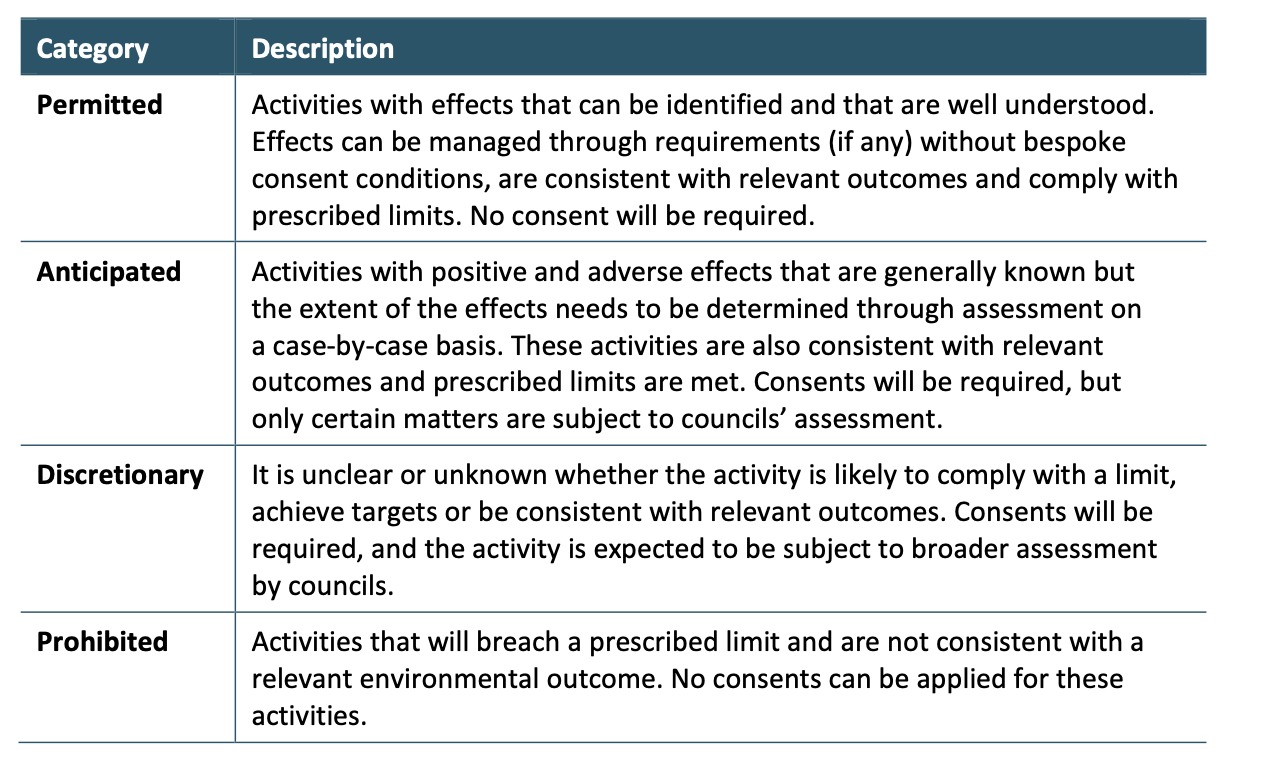
Under the new system, the NPF or NBE plans can permit activities. Some of these activities can only be categorised as permitted if they meet certain conditions set out in the NPF or NBE plan. NBE permitted activities can require third-party written approvals or certified reports prepared by suitably qualified persons. In such cases, the NPF or NBE plan will direct whether or not a permitted activity notice is required and, if it is required, the activity must not begin before the notice is issued.
Resource consents will be required for activities categorised within the anticipated and discretionary activity categories. The NBA is intended to drive more consistent categorisation of activities and provide for a more outcomes-focused approach. The level of assessment will therefore be proportionate to the complexity of the application and the potential outcomes and effects.
Transition and implementation
The new RM system will be phased in over time. Some changes take effect immediately. However, the transition from the RMA to the SPA and NBA will occur sequentially and region-by-region. Different regions will switch over at different times and until a region has both an RSS and NBE plan in place, much of the RMA will continue to apply. This includes current national direction, regional policy statements and plans, and many processes such as consenting and designations.
There are a range of work programmes underway to support a successful transition and implementation process. Implementation will be regionally led and build on existing knowledge, work and relationships of councils, hapū, iwi and Māori and everyone who uses the new system.
Some regions will be ready to implement the new system earlier than others. The Government will support and work closely with these first regions to establish their RPCs, and to develop their RSS and NBE plans.
This first group of regions will help demonstrate how workable the new system is, provide lessons for the regions that follow, and inform the type of support and system improvements that may be needed.
Work is also underway to explore how the government can support the regions that follow to prepare for their transition.
Almost every Treaty settlement to date includes natural resources redress, which interacts with the RMA. Engagement with post-settlement governance entities and other relevant groups is underway to reach agreement on how to continue to uphold Treaty settlements and other arrangements in the new system.
Transitional National Planning Framework
The transitional NPF is the initial step in delivering national direction for the new resource management system. It will be in place in 2025, in time to inform the development of the first RSS.
To facilitate a smooth transition from the RMA, the transitional NPF will be prepared on the basis of existing RMA national direction as long as it is compatible with the requirements of the NBA. It will provide direction to support the delivery of the RSS.
Most existing RMA national direction will be incorporated into the transitional NPF, including the National Policy Statement for Freshwater Management, the National Policy Statement on Urban Development, the RMA’s Medium Density Residential Standards, the National Policy Statement for Highly Productive Land and the National Policy Statement for Indigenous Biodiversity. The content of some RMA national direction instruments will not be included in the transitional NPF as they are currently being amended or need updating to work effectively in the new system.
Any content required by the NBA that is not included in the transitional NPF will be included in a notified change to the NPF by 1 January 2028.
Objectives for the new system
The Government’s objectives for the new resource management system are to:
-
protect and where necessary restore the natural environment, including its capacity to provide for the wellbeing of present and future generations
-
better enable development within environmental biophysical limits, including a significant improvement in housing supply, affordability and choice, and timely provision of appropriate infrastructure, including social infrastructure
-
give effect to the principles of te Tiriti and provide greater recognition of te ao Māori, including mātauranga Māori
-
better prepare for adapting to climate change and risks from natural hazards, and better mitigate emissions contributing to climate change
-
improve system efficiency and effectiveness, and reduce complexity, while retaining appropriate local democratic input.
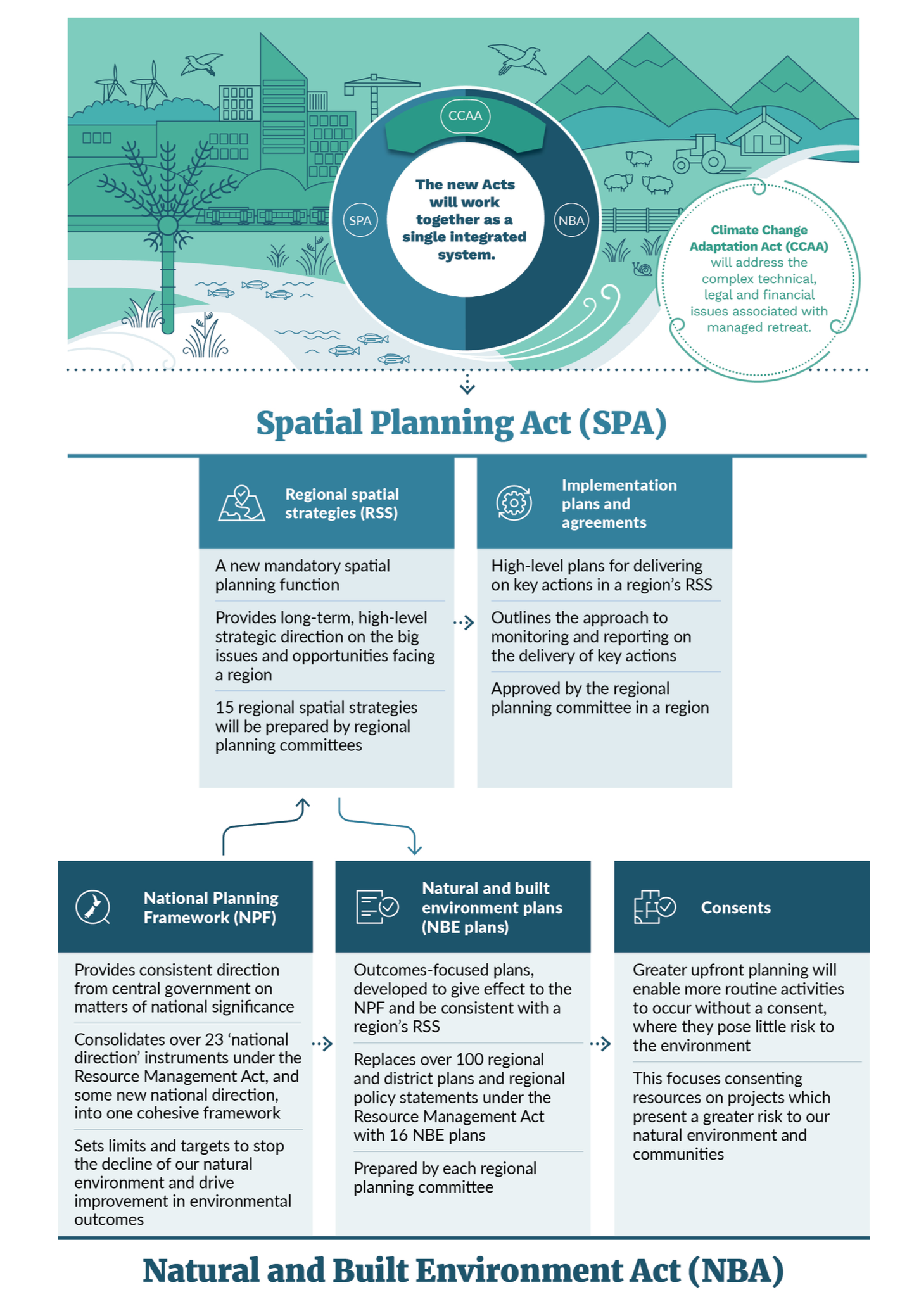
Changes that apply immediately
Some changes start the day after Royal assent:
- 10-year reviews of plans are no longer mandatory
- some freshwater-related resource consents under the RMA are subject to maximum duration controls
- a fast-track consenting process is available for specified applications
- some compliance and enforcement provisions are applied
- some provisions relating to contaminated land and aquaculture are applied
Summary and commencement of new tools and requirements:
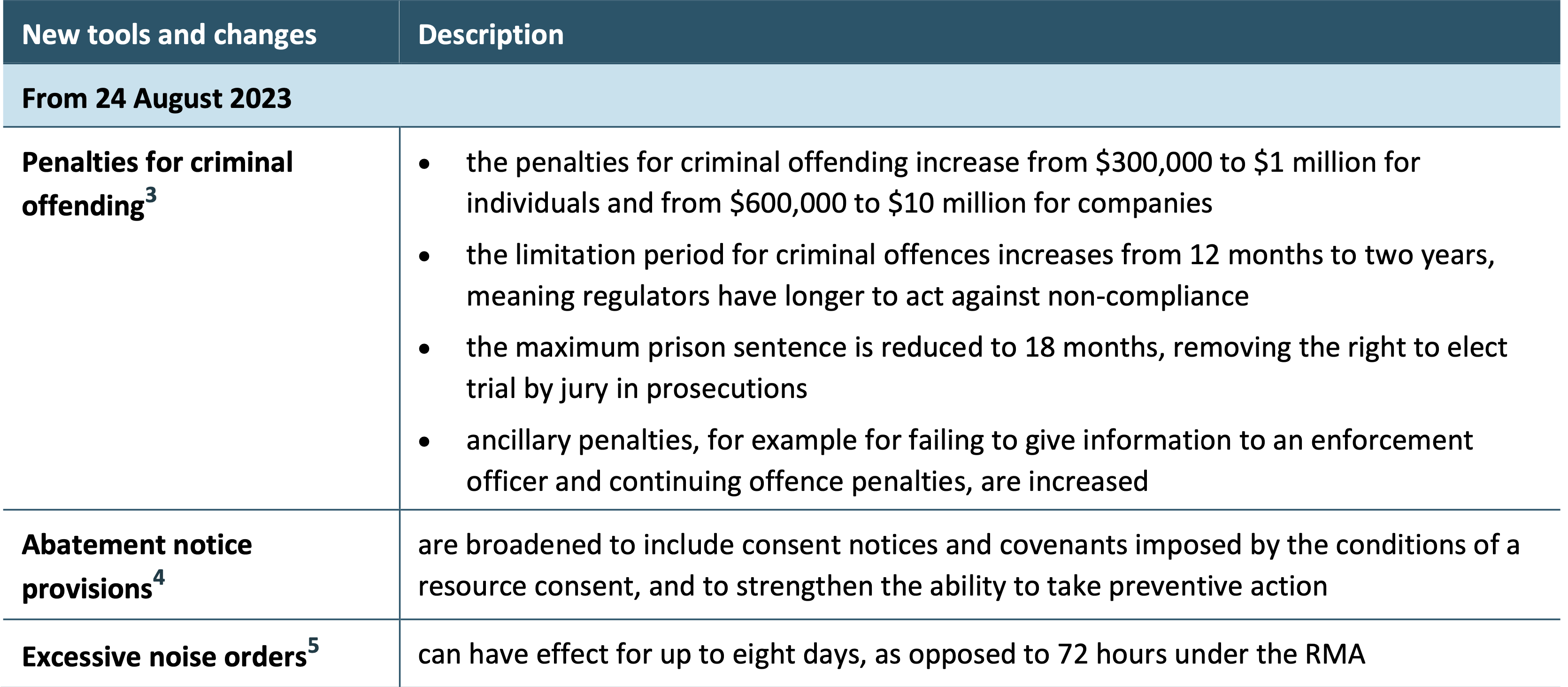
When requiring authority and designation provisions commence, are saved or transitioned:
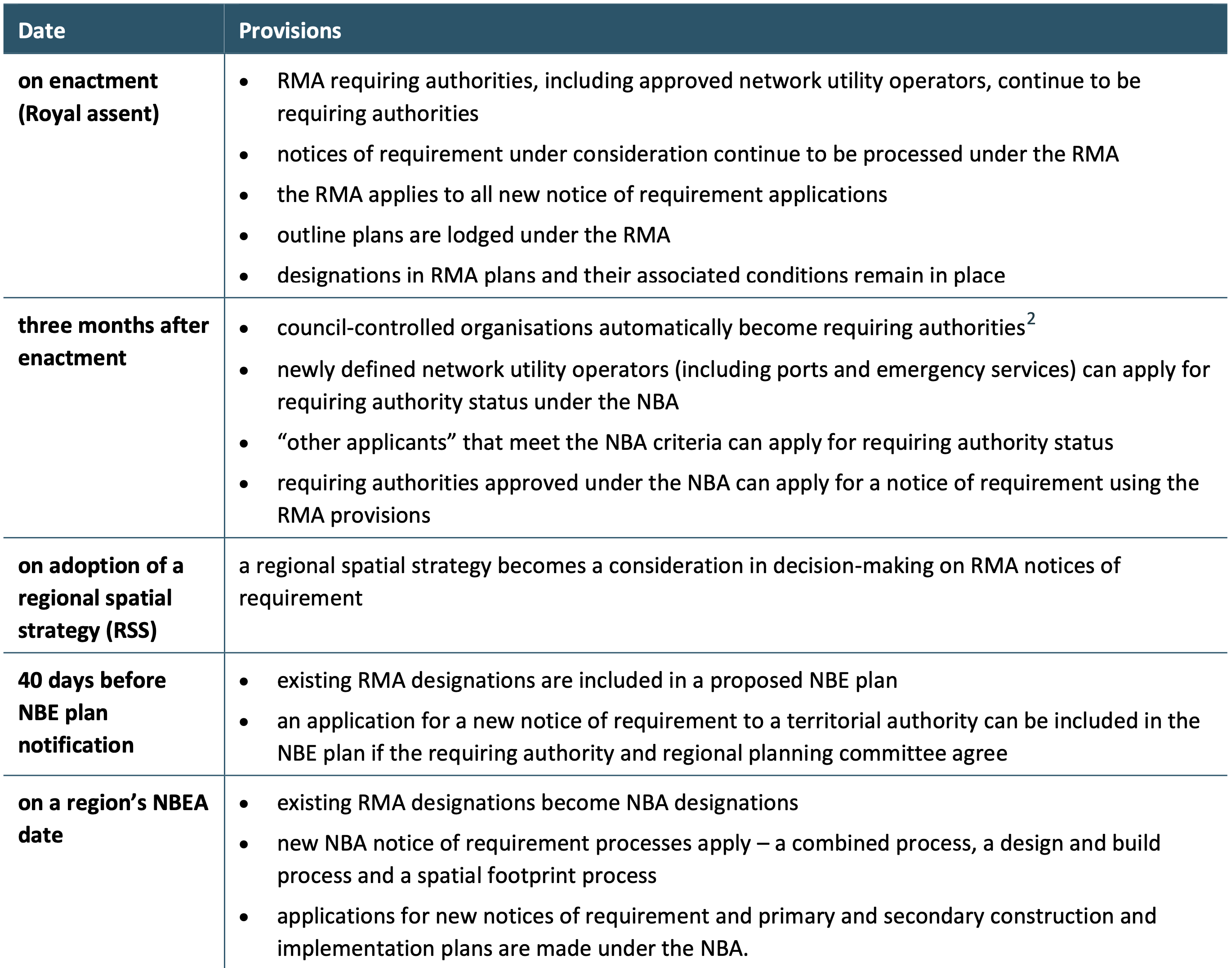
How policy statements and plans commence, are saved or transitioned:
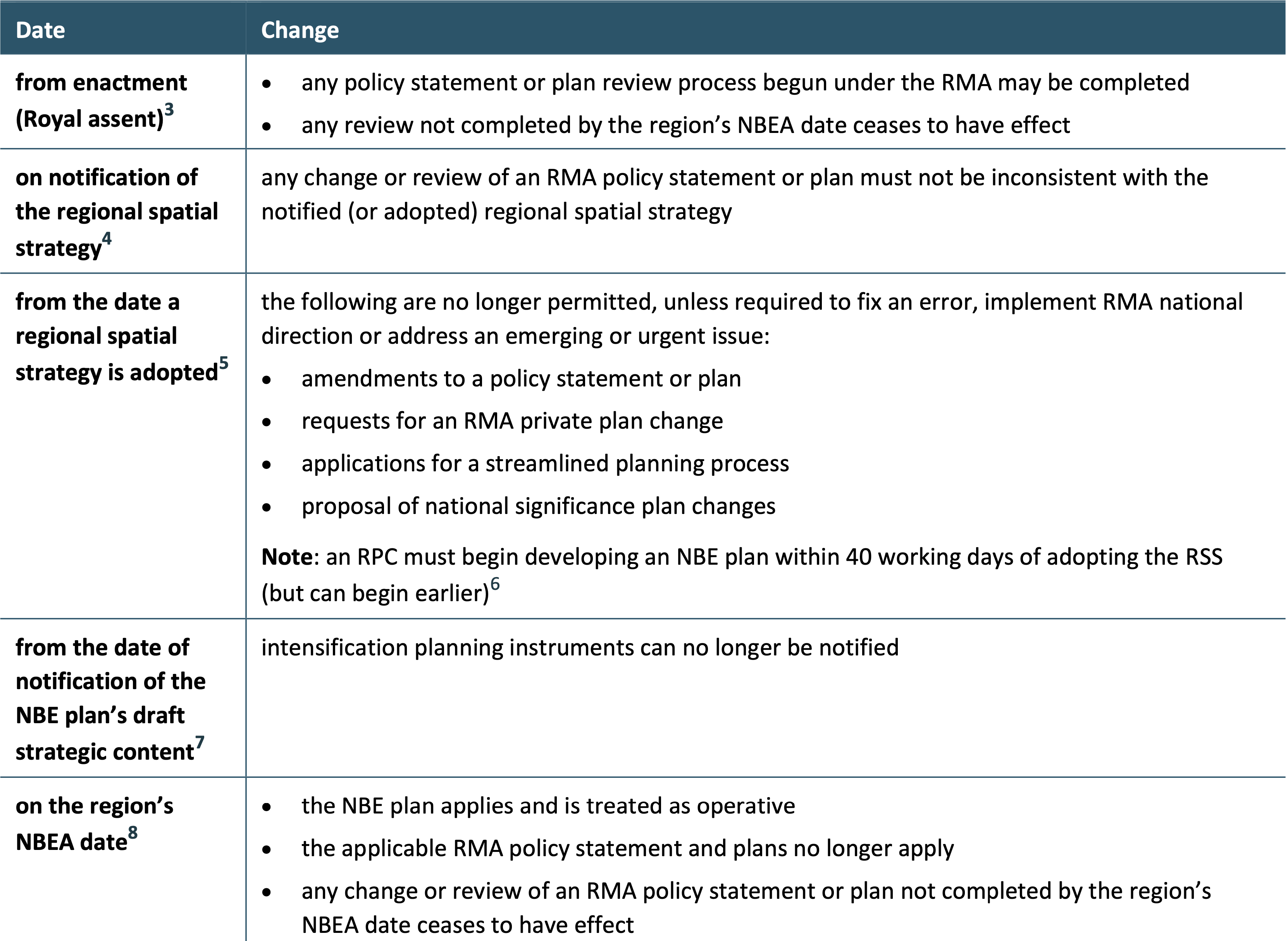
Once approved as requiring authorities “other applicants” can apply for notices of requirement and have powers to compulsorily purchase land. The Minister has the power to revoke requiring authority status in certain circumstances:

Activities eligible for fast-track consenting:
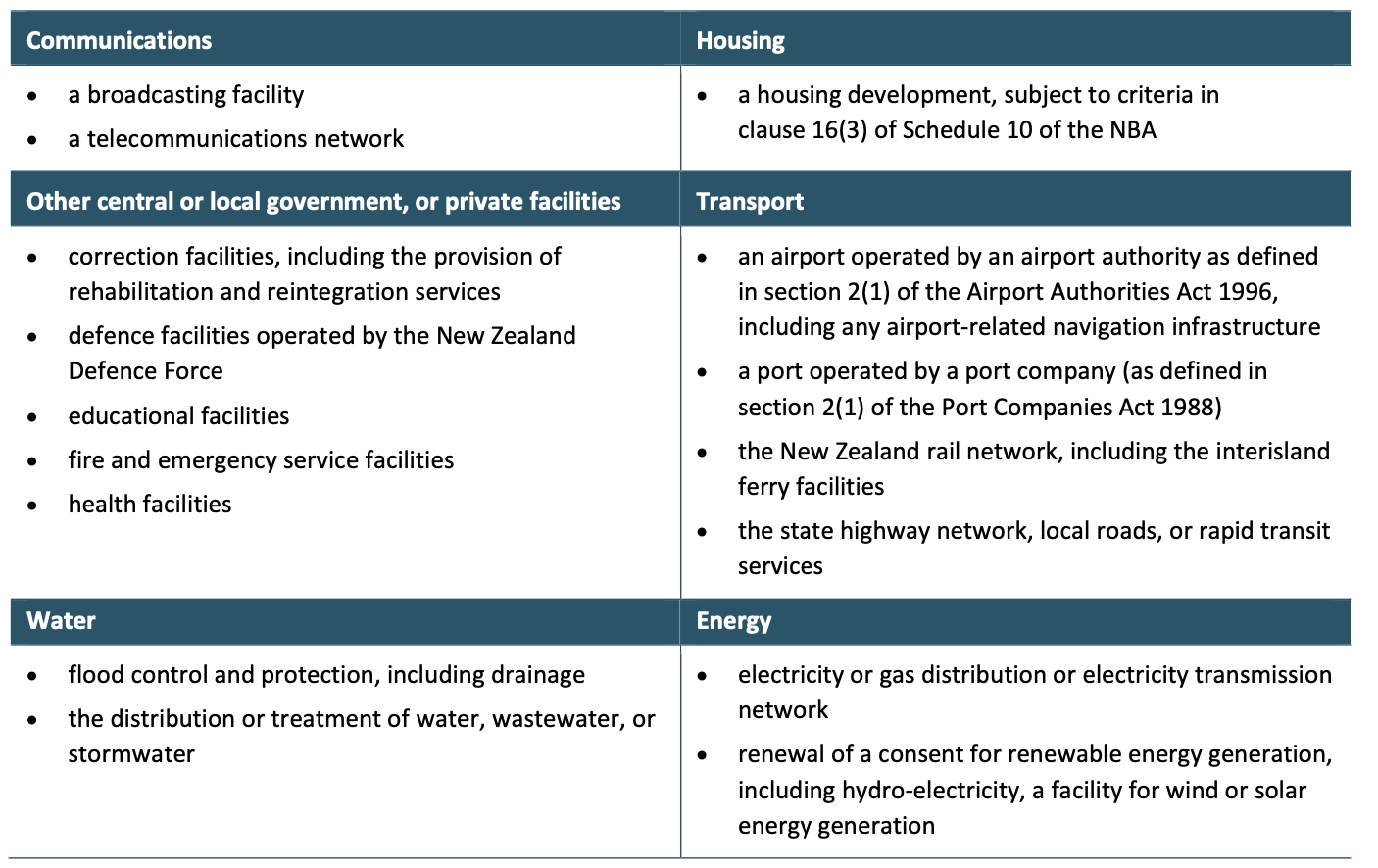
Key components of the new resource management system:
